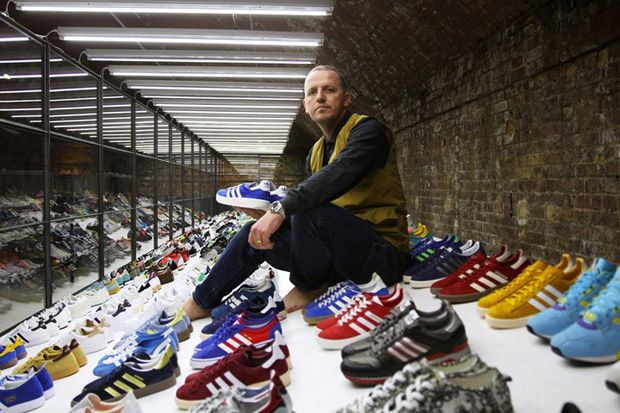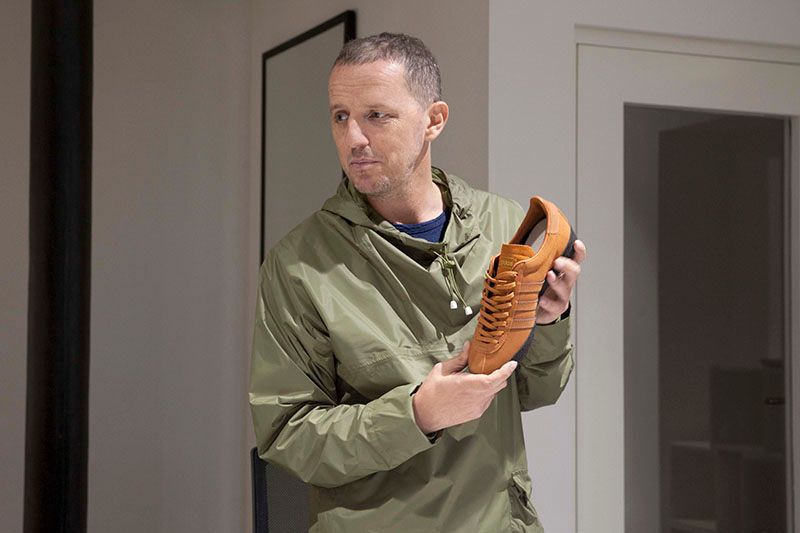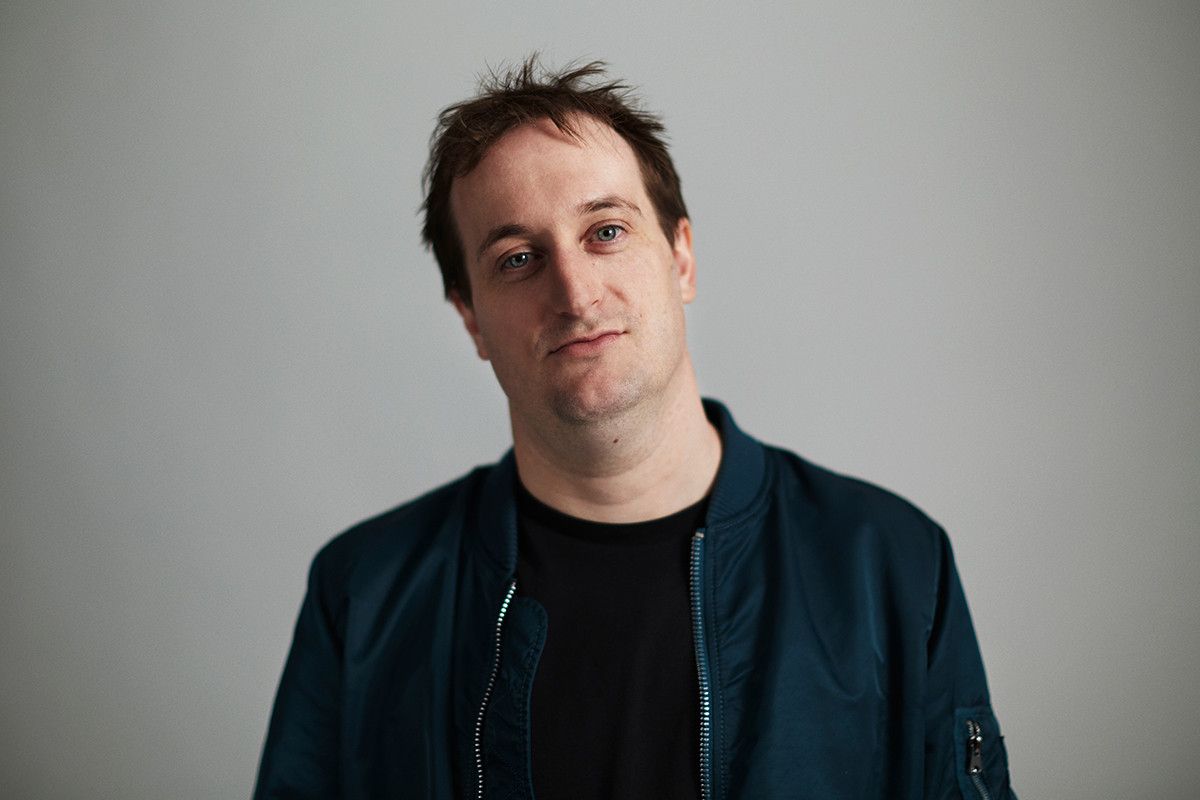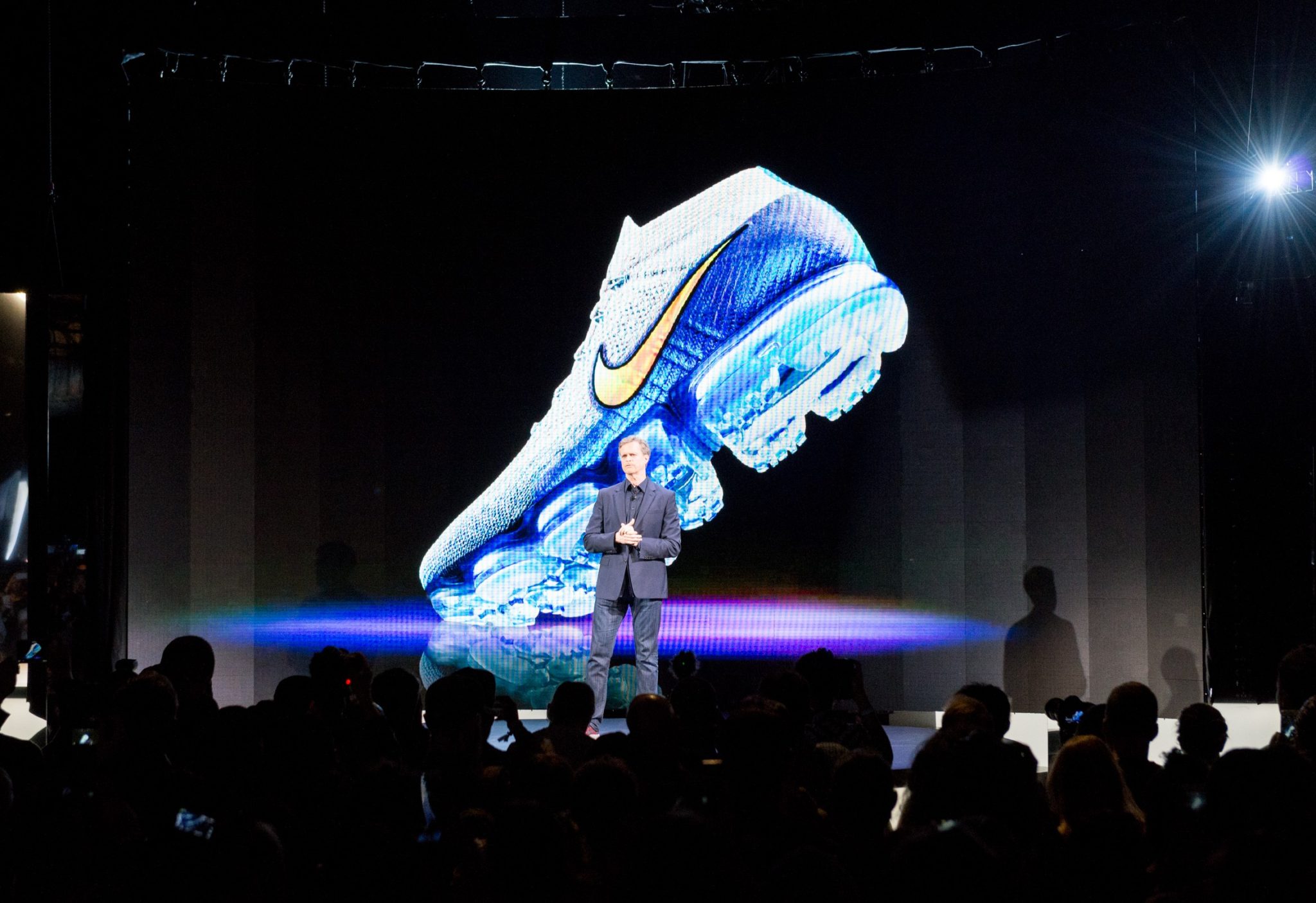GARY WARNETT Remembered: An Interview with ADIDAS SPEZIAL Boss GARY ASPDEN
|Gary Warnett
Today we remember our friend, dog lover, and sneaker king GARY WARNETT – who died one year ago and would have been 40 this year. Tributes by friends, colleagues, and readers have been paid on social media for a writer, critic, and streetwear savant lost much too soon. Reebok, the footwear giant from northern England, have created a Gwarzim shoe in his memory. Below we republish an interview Warnett held with Adidas SPEZIAL chief Gary Aspden – just a tiny fragment of the journalistic output by the former 032c contributor.
The genesis of Britain’s fascination with sportswear begins in the North of England. Arguments abound regarding the overused and oft-abused “casual” appellation to denote the terrace dwellers who made a brand like adidas – which once seemed so exotic to those attempting clean living in drab surroundings – synonymous with cities like Manchester and Liverpool. Brand consultant GARY ASPDEN – born and raised around Blackburn, a former mill town with a passion for football – is an Adidas fanatic who got his opportunity to display what the 3-stripes mean to him and legions of fellow connoisseurs. Aspden is at the head of SPEZIAL, an adidas capsule collection of apparel and shoes, which launches with a short archaeological film featuring an adidas-dedicated store in Argentina, as well as an exhibition in Manchester showcasing iconic and occasionally under-appreciated footwear: Gary Warnett in conversation with Gary Aspden.

Gary Warnett: With SPEZIAL, were you trying to bring back the detail-led approach that defined brands all those years ago?
GARY ASPDEN: I think it’s about execution. A lot of people say they don’t like marketing, but I don’t mind it if it’s presented to me properly, doesn’t treat me like I’m stupid and executed well.
With such a vast archive, was this more of a curation exercise?
With adidas, I felt like I’d been given access to the Crown Jewels. I see so many designers who use adidas as a reference, because they’re looking for ways to take elements without being sued. So why, with access to all that amazing design history, wouldn’t I want to play with that? I wanted to play to what I see as adidas’s strengths. They created some of the most iconic track suits ever and I wanted to look at that and see if I could move that on. I wore tracksuits as a youth and I’m now heading into being middle aged. I still like to wear tracksuits on a Sunday or when I’m going on a long distance flight. I want to wear a tracksuit that keeps with the way I dress now. That’s why I used a neutral colour palette.
Was the trip to a store in Argentina in the film more than just a video opportunity?
I was just beginning the look for the second season of SPEZIAL when we went to Argentina. Now I buy vintage pieces and archive them — there’s pieces I’m sitting on now that might not make an appearance for another four seasons — and I don’t know how long SPEZIAL’s going to run for either because the decision isn’t in my hands — but what Argentina was about was amassing products for research purposes, but also for finding interesting footwear to enhance what we were doing with SPEZIAL Manchester. What it does is enhance context — it helps to communicate the philosophy of the collection. It says a lot about the person curating the collection because, let’s face it, for anyone that’s a hardcore adidas fanatic, that trip is something we dream about. It shows that the collection has genuine roots, speaks for our mindset and if you’re going to say something’s archive-inspired, show me how you got from A to B. I wanna know! I don’t like to see stories attached to products unless they’re authentic. It starts and ends with product. The marketing stuff is the icing on the cake — the magic dust — but if the product isn’t fundamentally right, it’s unnecessary.
adidas was still broken into some rogue regional licenses until relatively recently — was Argentina the the last adidas license holder?
I think it was either Argentina or South Korea. Japan’s license ended in 1998. In Argentina the license holder held on to the death and when adidas started its three divisional structure in 2001, they needed to clear up adidas Originals. In 1999, when I started, there was no trefoil clothing available over here. They’d rinsed it out in the mid 1990s with Britpop so they just weren’t doing it at all, but they were doing it in America for some reason. So I was doing swaps. I’d go to adidas global marketing meetings looking out for people from licensee countries so I’d send them something signed by a band and they might send me a box of adidas New York made under license for Argentina.There was no system internally and you couldn’t order from the licensed countries so I used to do this bartering and trading.
Now you can buy the same thing everywhere. Those differences had a certain charm.
There weren’t global brands then like you see now. You don’t see so much branded clothing on people in the 1960s and 1970s. adidas was an early global brand, so licensees was probably a good way of getting out there. Then the money men realised that it wasn’t that cost effective, so they wanted to centralise. I’m sure money men would see me as a hopeless romantic. There’s a generation who think that 1980s adidas was the ultimate sportswear — you had the ZX series, the city series…in adidas’s history it’s seen as a difficult time for the company. Karl-Heinz Lang, who worked as a developer for Adi Dassler, used to roll his eyes when you mentioned the city series. He worked on the development of the Marathon TR in the late 1970s and those city series shoes were just done to make money for licensees. adidas’s commitment to performance was way ahead of those gum-soled city shoes.Things like the adidas Waterproof and Zelda were pushing the envelope.
How hard is bringing back shoe shapes as you remember them? We obviously don’t have Spain or France handling manufacture and tooling and processes change.
The thing I’ve learnt is that the gum soled stuff is actually quite hard to bring back because the lasts from that era are very different to the ones we have now. I’m currently working on shoes for winter 2015 and if you haven’t got the right last…I’ve been to see the guy in charge of the lasts and he’s an amazing guy. He’s been at adidas for 30 years and his father was employee #19. It’s in his blood! I’ll go up there with a vintage shoe and we’ll actually look for the last that’s as close to it as possible. If I can’t find the right last, we have to say no. We’ve got to second round samples we had to scrap because it wasn’t near enough. I’d rather it be dropped. There’s people out there who trust my judgement on these things because I’m one of them.
What were the inspirations for the range beyond adidas specifically?
When it came to starting the project, I wrote a list of reference points with aspects of German art and culture that I am a fan of, so I wrote down this list and it was like, Walter Gropius, Joseph Beuys, Gerhard Richter, Neu!, Can and La Düsseldorf. I kind of wrote that list, and looking at Gropius and the Bauhaus, what I came up with was that his philosophy was all about craft, design, technology — similar to Adi Dassler. They shared that philosophy and they were both around in the same era. What I also started to think about was Factory Records and this very Germanic reference and the connection with the north of England. But I also started to think about the references as I got a bit older and, of course, Massimo Osti was a big one. His company was called Sportswear International and from the start until not too long ago, he would use the 3 stripes. There was something very masculine about what he was doing so in a way, what I saw with Osti — and this is me philosophising, so it may not be the truth — is that this idea of craft, design, technology that these guys were doing in Germany in the 1930s, was the same as what Osti was doing in the 1980s. But I wouldn’t put Stone Island as a reference for the collection. The other Italian brands that I’m a huge fan of are Brunello Cucinelli and Loro Piana — the thing about Loro and Brunello is that they’re extremely expensive, extremely conservative Italian luxury brands, but the fact that they’re so conservative makes them a blank canvas that’s ripe for adoption. Once you’ve hit those high-end luxury brands, unless you’re into the avant-garde, left field fashion like Dover Street Market’s world, there’s nowhere to go after that — well, maybe to tailoring. They’re the pinnacle for me. They’re the brands that, once you’ve made it, you wear them effortlessly. They’re subtle and unlabelled and I love that about them — they’re outside and playing by a completely different set of rules to what you see on the hype sites or in the fashion magazines. It’s unaffected by trend.

Having seen an early preview of spring / summer 2015’s SPEZIAL film, it seemed defiantly Germanic.
Yeah, defiant’s a good word for it. I’ve also been thinking about the word contrarian as it applies to it. It’s completely against the grain. When things start feeling expected there’s something in me that rears up and wants to challenge it. I don’t like to feel that weight of expectation. In many ways, what we’re presenting with SPEZIAL is contrary to many things happening in global culture. I’d rather do that and fail than compromise and do something that was a “success”. I say what I say because I have an emotional attachment to it, just like a lot of people who grew up with it do. I’m just on the other side of the fence. It’s not for the cheque.
There’s something about the whole Germany thing — Christiane F. and Bowie in Berlin often crop up as reference points — that connects to this. Why does that influence sustain?
It’s not even just a look, is it? There’s a magic to it. There’s an ambiance that’s subtle. There’s something exotic about it. During that period a lot was left to the imagination — it wasn’t documented to the nth degree like things are now. I always think that the human imagination is far more powerful than documentation was. With New Order when I was a kid, they rarely did interviews. You just got this incredible piece of art outside and inside the LP. Then the music. It preserved a mystique so you had to read into it what you will. I think it’s like that with the German thing. It’s Bowie, but it’s so much more.
He seems to be the liberator and catalyst.
He was the poster boy during that era. What he was good at was spotting talent. What he did with Iggy Pop and Lou Reed he was doing with Neu! and Can. For me Bowie was about the older guys who I looked up to, so it’s intrinsic to my youth. My Bowie was the 1980s one that I’m not so keen on, but I grew up hearing from these guys telling stories of Iggy Pop playing in Manchester with Bowie on the keyboard. I’d hear this mythology and as you get older, you join the cultural dots. You see the connections between rap, Blondie, the Specials at the Roxy…you attach a lot to mystery.
That Factory and Germany connection is very literal here. You’ve got Bernard Sumner in the lookbook and the floppy disc tee. Was that a direct nod to that link?
Factory changed my life. Those guys should have been given the keys to Manchester for what they did for it. They opened up this idea that if you picked up a New Order album you got a piece of art. It was mind-blowing when I first got into it in the 1980s but it’s more mind-blowing to me now. The floppy disc could be associated with New Order but it’s also a comment on adidas Originals. When I first got a computer I had 1K memory that I upgraded to 16K. Then a 16K computer that I upgraded to 48K, you know? I used to play a game on a tape recorder. The floppy disc was the cutting edge of technology then! You see one now and aesthetically it looks beautiful but you don’t take it seriously from a technical standpoint. It’s the same with an LA Trainer — back when it debuted people were adjusting the plugs in the heel for running marathons and now you look at them and aesthetically they’re nice, but you don’t take them seriously from a technical standpoint now. That’s what adidas was — technologies that you can appreciate now for their aesthetic value.
What are the roots of the north of England and Germany connection? Before Factory there was those things we hear, like Ian Curtis watching a Herzog film and listening to an Iggy Pop album from that Berlin period before he killed himself. Then there was Kraftwerk’s impact on the Sheffield sound.
Your environment definitely affects your taste and in the north it’s a very industrial environment. In the design language of adidas there’s something that resonates with that part of the country. With the Germanic stuff, I’m too young to really say — there’s a theory about Bowie and The Man Who Fell to Earth, in the duffle coat with the orange hair and brown shoes and the impact of that on a generation — that look could work right now. Then you can start looking at Bowie’s Berlin period and the fact he was working with Eno.
Eno produced Bowie and A Certain Ratio from Manchester connect to that.
Well, Eno did a song called “The True Wheel,” which talks about, “a certain ratio”, which is where they took their name from. And then there was Roxy Music who were a big influence on the Sex Pistols — Steve Jones and Paul Cook had a group called The Strand before the Pistols. I have a theory about Talking Heads and Lacoste too. They appeared on The Old Grey Whistle Test with Lacoste polo shirts on — that super normal look which was almost in keeping with what was happening in the terraces at the time. They played at Eric’s in Liverpool at the same time. I mean, that’s pure mythology and speculation. And they were being produced by Eno — and he released King’s Lead Hat in December 1977 which was an anagram of “talking heads” a few months after the first Talking Heads album was released. I go back to this stuff again and again. I just finished the playlist for the Manchester SPEZIAL exhibition. It’s all basically Bowie and loads of instrumentals. I didn’t want to be like, “Hey man, it’s sneakers! Let’s put a hip-hop beat under it.”

Did you consider displaying the packaging in the exhibition? There’s a real beauty to those old adidas boxes.
We nearly did a glass case of blue boxes last time. In many ways the shoe boxes hold their old value and they’re a little too easy to crush. I brought quite a bit of stuff back from Argentina, like the boxed tracksuits. I wanted to do the boxes for SPEZIAL tracksuits, but you’d have to buy them as an outfit and I thought that might be a little too much.
Are you still steering clear of labelling with the names of shoes and the year for this exhibition?
Yeah. For starters, it makes life easier and saves time, but it also presents the product in a democratic way, free of hype and marketing. let’s just look at them as products. I just like the idea of people looking at them for what they are rather than what people attach to them — they’re freed of the mythology. It’s almost impossible to lock down elements of dating and naming because of the unfathomable depth and licensing. I just came back from Argentina with a pair of ZX 390 — nobody knows what they are and the soles have completely crumbled. I took them to Germany to get resoled and being German, the developers wanted to know what the right sole is, but that fact is, nobody knows.
Nobody will ever know.
Except maybe some guy in Argentina who retired 30 years ago and is at home with his family completely oblivious to all this stuff! [Laughs.]
Have you accepted that the quest to see and know everything about this brand is an infinite task?
I accepted that many years ago, but that’s part of what I love about it — there’s no finality to it. So you’re always hunting that next thing.
What’s the key to longevity in design?
Designs like the Stan Smith and Gazelle will be as embedded in culture as a desert boot or brogue. You might get a shoe like a basketball shoe with a bit of technology on it from the late 1990s that has a buzz, but the heat’s gonna go eventually. There’s a quote from Andy Warhol in The Philosophy of Andy Warhol that sums that up:
“When a person is the beauty of their day, and their looks are really in style, and then the times change and tastes change, and ten years go by, if they keep exactly their same look and don’t change anything and if they take care of themselves, they’ll still be a beauty. Schrafft’s restaurants were the beauties of their day, and then they tried to keep up with the times and they modified and modified until they lost all their charm and were bought by a big company. But if they just could have just kept their look and style and held on through the lean years when they weren’t in style, today they’d be the best thing around. You have to hang on in periods when your style isn’t popular, because if it’s good you’ll be a recognized beauty once again.”
Some brands have several design classics that they use as the foundation of their business, but how many has adidas got? I mean, the Beckenbauer tracksuit, the Firebird tracksuit, Colorado jackets, Gazelle … it’s ridiculous. And because it has that depth, certain things become hip for a while and die off — just sit on them for a while and their time will come again. You’ve got to curate the bits that are relevant for right now. I want SPEZIAL to reflect modernity. It’s not futuristic and it has echoes of our past without being stuck in it.
Credits
- Interview: Gary Warnett

